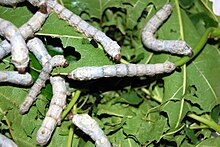
Back Sywurm Afrikaans Bombyx mori AN دودة القز Arabic ܙܚܘܪܝܬܐ (ܬܘܠܥܬܐ) ARC دودة القز ARZ Bombyx mori AST Tut ipəkqurdu Azerbaijani Тутавы шаўкапрад Byelorussian Копринена пеперуда Bulgarian তুঁত রেশম Bengali/Bangla
| Bombyx mori | |
|---|---|

| |
| Paired male (above) and female (below) | |

| |
| Fifth instar | |
Domesticated
| |
| Scientific classification | |
| Domain: | Eukaryota |
| Kingdom: | Animalia |
| Phylum: | Arthropoda |
| Class: | Insecta |
| Order: | Lepidoptera |
| Family: | Bombycidae |
| Genus: | Bombyx |
| Species: | B. mori
|
| Binomial name | |
| Bombyx mori | |
| Synonyms | |
| |
Bombyx mori, commonly known as the domestic silk moth, is a moth species belonging to the family Bombycidae. It is the closest relative of Bombyx mandarina, the wild silk moth. Silkworms are the larvae of silk moths. The silkworm is of particular economic value, being a primary producer of silk. The silkworm's preferred food are the leaves of white mulberry, though they may eat other species of mulberry, and even leaves of other plants like the osage orange. Domestic silk moths are entirely dependent on humans for reproduction, as a result of millennia of selective breeding. Wild silk moths, which are other species of Bombyx, are not as commercially viable in the production of silk.
Sericulture, the practice of breeding silkworms for the production of raw silk, has existed for at least 5,000 years in China,[1] whence it spread to India, Korea, Nepal, Japan, and then the West. The conventional process of sericulture kills the silkworm in the pupal stage.[2] The domestic silk moth was domesticated from the wild silk moth Bombyx mandarina, which has a range from northern India to northern China, Korea, Japan, and the far eastern regions of Russia. The domestic silk moth derives from Chinese rather than Japanese or Korean stock.[3][4]
Silk moths were unlikely to have been domestically bred before the Neolithic period. Before then, the tools to manufacture quantities of silk thread had not been developed. The domesticated Bombyx mori and the wild Bombyx mandarina can still breed and sometimes produce hybrids.[5]: 342 It is unknown if B. mori can hybridize with other Bombyx species. Compared to most members in the genus Bombyx, domestic silk moths have lost their coloration as well as their ability to fly.[6]
- ^ Barber, E. J. W. (1992). Prehistoric Textiles: the Development of Cloth in the Neolithic and Bronze Ages with Special Reference to the Aegean. Princeton University Press. p. 31. ISBN 978-0-691-00224-8.
- ^ Sh. S.D. Pateriya. "Introduction to Sericulture". https://www.ignfa.gov.in/document/biodiversity-cell-ntfp-related-issues4.pdf
- ^ K. P. Arunkumar; Muralidhar Metta; J. Nagaraju (2006). "Molecular phylogeny of silkmoths reveals the origin of domesticated silkmoth, Bombyx mori from Chinese Bombyx mandarina and paternal inheritance of Antheraea proylei mitochondrial DNA" (PDF). Molecular Phylogenetics and Evolution. 40 (2): 419–427. doi:10.1016/j.ympev.2006.02.023. PMID 16644243.
- ^ Hideaki Maekawa; Naoko Takada; Kenichi Mikitani; et al. (1988). "Nucleolus organizers in the wild silkworm Bombyx mandarina and the domesticated silkworm B. mori". Chromosoma. 96 (4): 263–269. doi:10.1007/BF00286912. S2CID 12870165.
- ^ Hall, Brian K. (2010). Evolution: Principles and Processes. Jones & Bartlett. p. 400. ISBN 978-0-763-76039-7.
- ^ "Captive breeding for thousands of years has impaired olfactory functions in silkmoths".
© MMXXIII Rich X Search. We shall prevail. All rights reserved. Rich X Search